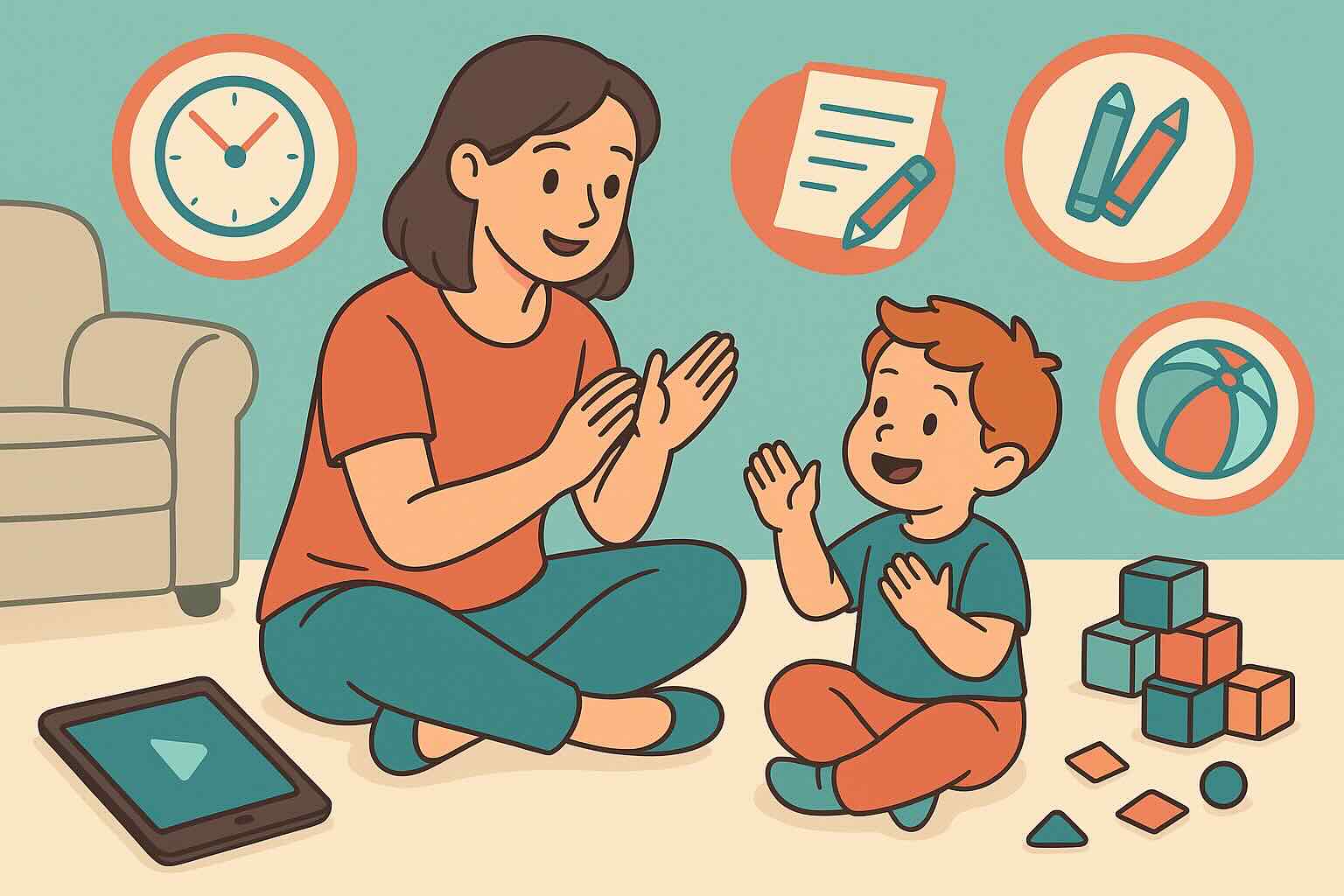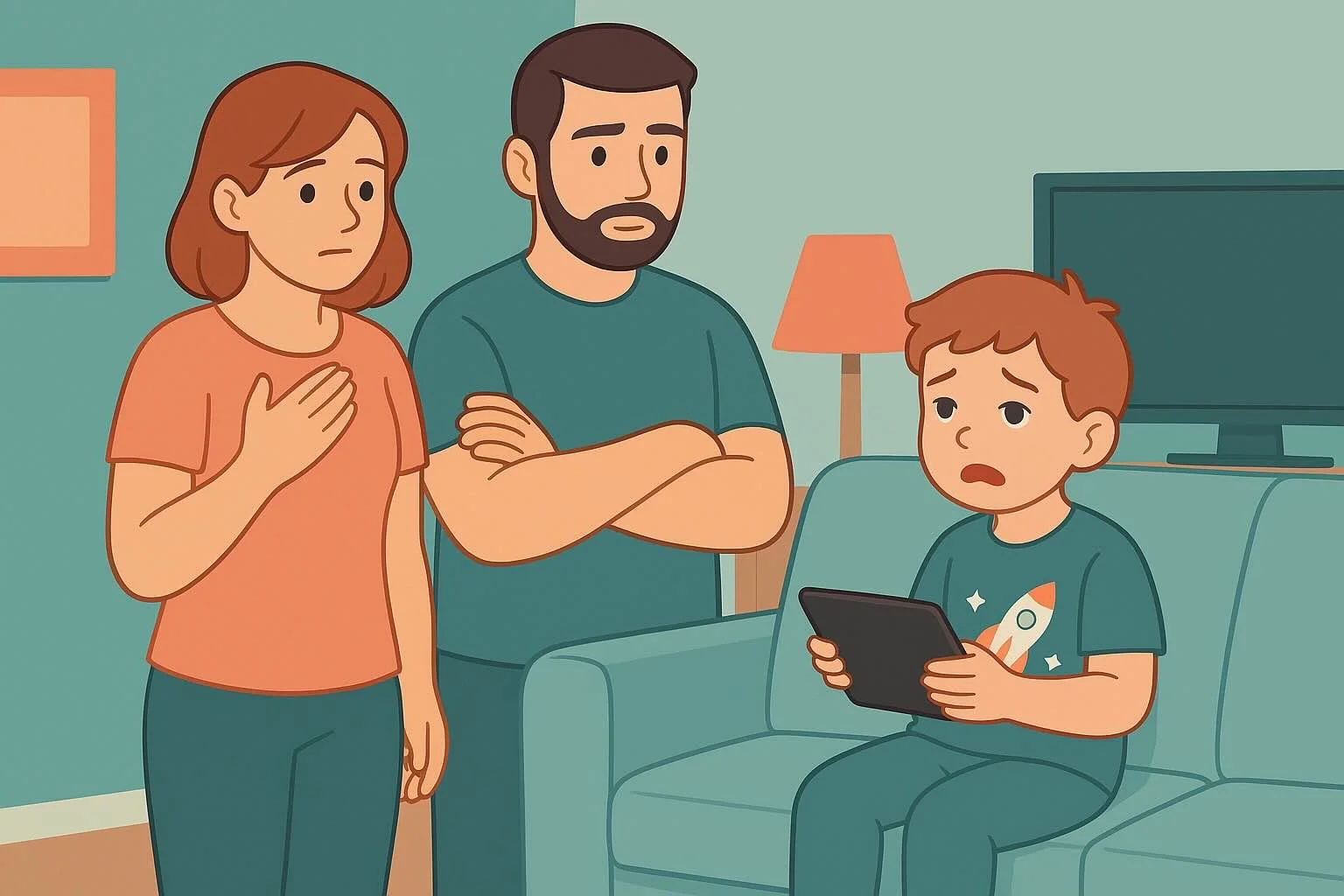Screen Time Alternatives: 200+ Activities That End Im Bored Forever


If your child's response to "screen time is over" is always "but there's nothing else to do," this comprehensive guide provides the solution. Research shows that children who have regular access to engaging non-screen activities develop better creativity, longer attention spans, and stronger problem-solving skills while naturally reducing their desire for excessive screen time.
This isn't just a list of activities—it's a strategic approach to creating an environment where non-screen options feel as appealing as digital entertainment, organized by your child's age, available time, and materials you have on hand.
What You'll Learn in This Guide
- The Science of Engagement - Why some activities compete with screens while others don't
- Age-Specific Activity Collections - 200+ activities organized by developmental stages
- Quick Setup Solutions - 5-minute activities for immediate screen time transitions
- Independent Play Builders - Activities that develop self-directed engagement
- Seasonal and Special Interest Categories - Activities for different times and interests
- Organization and Rotation Systems - How to keep activities fresh and accessible
- Troubleshooting Common Challenges - Solutions for "I'm bored" and activity resistance
For complete screen time support, also see our guides on creating healthy screen time boundaries, establishing family screen time rules, handling screen time meltdowns, and choosing educational vs entertainment content.
Estimated reading time: 15 minutes
The Science of Creating Screen-Competitive Activities
What Makes Activities Genuinely Engaging for Children 3-7
Key characteristics that compete with screen appeal:
Immediate Accessibility
- Materials are visible and easy to reach
- Setup time is minimal (under 5 minutes)
- Children can begin without waiting for adult preparation
- Clear storage and organization systems
Appropriate Challenge Level
- Not too easy (boring) or too hard (frustrating)
- Allows for skill building and mastery over time
- Can be modified to match child's current abilities
- Provides sense of accomplishment and progress
Sensory Engagement
- Appeals to multiple senses (touch, sight, sound, movement)
- Provides satisfying tactile experiences
- Allows for movement and physical activity
- Engages natural curiosity about how things work
Creative Control
- Children can make choices and decisions within the activity
- Open-ended possibilities rather than single "right" outcomes
- Allows for personal expression and individual approaches
- Can be modified or adapted based on child's interests
Understanding Why Children Say "I'm Bored"
Common reasons behind boredom complaints:
Transition Difficulty
- Moving from high-stimulation (screens) to lower-stimulation activities
- Need time to adjust and "come down" from digital engagement
- May need physical movement or sensory input to transition effectively
Choice Overwhelm
- Too many options can be paralyzing rather than exciting
- Children may need help narrowing choices to 2-3 specific options
- Clear organization helps children see possibilities without feeling overwhelmed
Lack of Play Skills
- Some children need to relearn how to engage with physical materials
- Independent play skills may need rebuilding if screen time has been dominant
- May need adult modeling and initial participation to rebuild interest
Unrealistic Expectations
- Children may expect constant entertainment rather than self-directed engagement
- Need to rediscover that boredom is normal and can lead to creativity
- Learning that adults don't need to solve the "problem" of boredom
Age-Specific Activity Collections
Ages 3-4: Foundation Building Activities
Characteristics of effective activities for this age:
- Simple setup with large, manipulable materials
- Clear beginning and end points
- Opportunities for repetition and mastery
- High sensory engagement
- Adult participation often helpful initially
Sensory and Fine Motor Activities (15-25 minutes)
Play Dough Creations
- Basic play dough with cookie cutters and rolling pins
- Add texture tools: forks, combs, stamps
- Hide small objects for "treasure hunting"
- Make pretend food or simple animals
Water Play Stations
- Sink or large container with cups, funnels, and sponges
- Add food coloring for color exploration
- Include floating and sinking toys
- Water painting on fences or sidewalks
Sensory Bins
- Rice or pasta with hidden toys to find
- Beans with scoops and containers
- Shredded paper with small cars or animals
- Sand with molds and digging tools
Art and Creativity (10-20 minutes)
Large Motor Art
- Easel painting with large brushes
- Finger painting on big paper
- Chalk drawing on sidewalks or driveways
- Painting with water on exterior walls
Simple Craft Projects
- Sticker scenes and sticker books
- Tearing and gluing colored paper
- Decorating paper plates or bags
- Simple collages with magazines
Building and Construction (20-30 minutes)
Block Play
- Large wooden blocks or cardboard boxes
- Duplo or large Lego sets
- Magnetic tiles (supervised for safety)
- Stacking and knocking down towers
Dramatic Play (15-25 minutes)
Dress-Up and Role Play
- Simple costumes: hats, scarves, oversized clothes
- Playing house with dolls or stuffed animals
- Pretend cooking with play kitchen items
- Doctor or veterinarian play with stuffed animals
Movement and Outdoor (20-40 minutes)
Gross Motor Activities
- Dancing to music with scarves or ribbons
- Simple obstacle courses with pillows and furniture
- Ball play: rolling, throwing into containers
- Riding toys or push toys
Nature Exploration
- Collecting leaves, rocks, or sticks
- Bug hunting with magnifying glasses
- Water play in garden or sandbox
- Simple gardening: planting seeds or watering
Ages 5-7: Skill Development Activities
Characteristics of effective activities for this age:
- More complex, multi-step projects
- Opportunities for planning and problem-solving
- Independent execution with minimal adult help
- Integration of academic skills through play
- Longer engagement periods possible
Academic Integration Activities (25-45 minutes)
Reading and Language
- Independent reading of picture books
- Creating their own books with drawings and simple text
- Storytelling with props or puppets
- Word games and rhyming activities
Math Through Play
- Board games that involve counting or strategy
- Measuring ingredients for simple cooking
- Sorting and categorizing collections (rocks, shells, toys)
- Building with blocks while counting and measuring
Science Exploration
- Simple experiments: volcanoes, color mixing, floating/sinking
- Nature journals with drawings and observations
- Magnifying glass exploration of insects or plants
- Weather tracking and outdoor observations
Advanced Art and Craft Projects (30-60 minutes)
Complex Creative Projects
- Friendship bracelets or simple weaving
- Model building with clay or recyclable materials
- Detailed coloring books or adult coloring pages
- Simple sewing projects with large needles and felt
Engineering Challenges
- Building bridges or towers with specific requirements
- Creating marble runs with cardboard tubes
- Designing and testing paper airplanes
- Building forts with blankets and furniture
Independent Play Builders (30+ minutes)
Open-Ended Exploration
- Extensive Lego or building set projects
- Elaborate dramatic play scenarios with multiple characters
- Art projects that evolve over multiple sessions
- Collection organizing and display creation
Puzzle and Problem-Solving
- Age-appropriate jigsaw puzzles (50-100 pieces)
- Brain teaser games and logic puzzles
- Pattern recognition games
- Strategy games they can play independently
Quick Transition Activities (5-15 minutes)
Immediate Post-Screen Activities
Why quick transitions matter: Children need time to adjust from high-stimulation screen content to other activities. These bridge activities help manage the neurological transition while preventing the "there's nothing to do" complaint.
For understanding the science behind difficult screen transitions, see our screen time meltdowns guide.
High-Energy Transitions
For children who need physical movement after screens:
- Dance party: Put on 2-3 favorite songs and dance
- Jumping games: Hopscotch, jumping jacks, trampoline if available
- Ball activities: Bouncing, throwing into containers, juggling scarves
- Outdoor sprint: Quick run around the yard or building
- Yoga poses: Simple animal poses with stretching
Calming Transitions
For children who seem overstimulated after screens:
- Deep breathing exercises: "Smell the flower, blow out the candle"
- Quiet music listening: Classical or nature sounds with relaxation
- Gentle stretching: Cat and cow poses, reaching for the sky
- Mindful observation: Looking out windows and describing what they see
- Fidget toys: Stress balls, fidget spinners, or textured objects
Creative Quickstarts
Activities that can begin immediately and expand over time:
- Drawing prompts: "Draw your favorite animal" or "design a new toy"
- Story starters: Begin telling a story and let them continue
- Building challenges: "Build something tall" or "create an animal"
- Imagination games: "What would happen if..." scenarios
- Music making: Simple instruments or singing familiar songs
Extended Engagement Activities (45+ minutes)
Projects That Develop Deep Focus
Characteristics of long-engagement activities:
- Can be worked on over multiple sessions
- Allow for personal creativity and choice-making
- Have clear goals but flexible approaches
- Provide sense of accomplishment and mastery
Multi-Session Projects
Art and Craft Endeavors
- Painting series: Multiple canvases exploring a theme
- Sculpture projects: Clay works that develop over several days
- Collage collections: Gathering materials and creating over time
- Seasonal decorations: Holiday or weather-themed projects
Building and Engineering
- Elaborate constructions: Cities, castles, or machines with blocks/Lego
- Fort building: Ongoing construction and improvement projects
- Model making: Airplanes, cars, or buildings from kits or recyclables
- Garden projects: Planning, planting, and maintaining small garden spaces
Learning Adventures
- Research projects: Exploring favorite animals, countries, or topics
- Collection building: Rocks, leaves, stamps with organization and learning
- Science investigations: Multi-day experiments with observation journals
- Historical exploration: Learning about time periods through books and activities
Independent Play Development
Building the ability to play alone meaningfully:
Setup Strategies for Independent Play
Create Activity Stations
- Art station: Always-available paper, crayons, scissors, glue
- Building corner: Blocks, Lego, or magnetic tiles with storage
- Reading nook: Comfortable seating with book selection
- Dramatic play area: Costumes, props, and designated space
Rotation Systems
- Weekly activity boxes: New activities introduced every Monday
- Seasonal material swaps: Summer outdoor tools, winter indoor crafts
- Interest-based rotations: Dinosaur week, space week, art week
- Skill-building progressions: Puzzles that gradually increase in difficulty
Teaching Independent Play Skills
For children who struggle with self-direction:
Start Small and Build
- Begin with 10-15 minutes of independent activity
- Gradually increase time as children develop comfort
- Stay nearby initially, then slowly increase distance
- Provide specific activity suggestions rather than open-ended choices
Problem-Solving Support
- Teach children to try 3 different activities before asking for help
- Create visual guides for setting up favorite activities
- Practice "boredom busting" strategies during calm times
- Celebrate independent play successes enthusiastically
Seasonal and Special Interest Activities
Seasonal Activity Collections
Spring Activities
- Gardening: Planting seeds, watering, observing growth
- Nature crafts: Flower pressing, leaf rubbings, stick sculptures
- Outdoor exploration: Bug hunting, bird watching, nature walks
- Spring cleaning: Organizing toys, washing outdoor toys
Summer Activities
- Water play: Sprinklers, water balloons, car washing
- Outdoor art: Sidewalk chalk, painting on fences, nature mandalas
- Active games: Tag variations, hide and seek, outdoor obstacle courses
- Nature study: Camping in the backyard, star gazing, nature journals
Fall Activities
- Harvest themes: Apple activities, pumpkin exploration, leaf collection
- Preparation projects: Winter decorations, gift making, planning activities
- Cozy indoor setup: Reading forts, puzzle marathons, soup making
- Nature crafts: Pine cone projects, acorn collections, seasonal decorations
Winter Activities
- Indoor active play: Dance parties, yoga sessions, indoor sports
- Craft intensives: Long-term art projects, holiday preparations
- Cooking projects: Baking, soup making, hot chocolate experiments
- Reading marathons: Book series, library visits, storytelling
Interest-Based Activity Categories
For Animal Lovers
- Animal research: Books, documentaries, fact collection
- Pet care simulation: Stuffed animal veterinarian play
- Habitat creation: Building animal homes with blocks or boxes
- Animal movement: Acting like different animals, animal yoga
For Vehicle Enthusiasts
- Transportation sorting: Organizing toy cars, planes, boats
- Road building: Creating cities and roads with tape or blocks
- Vehicle crafts: Making cars from recyclables, airplane competitions
- Transportation research: Learning about how different vehicles work
For Art and Craft Lovers
- Medium exploration: Trying different art supplies and techniques
- Art history exposure: Looking at famous paintings and trying similar styles
- Craft skill building: Learning specific techniques like weaving or origami
- Art display creation: Setting up galleries for their own work
For Building and Engineering Fans
- Architectural challenges: Building specific structures with requirements
- Simple machines exploration: Levers, wheels, pulleys with household items
- Engineering problems: How to build something taller, stronger, or more complex
- Real-world building: Helping with household projects appropriately
Organization and Accessibility Systems
Creating an Activity-Rich Environment
Storage Solutions That Encourage Use
Clear, Accessible Storage
- Transparent containers: Children can see what's available
- Low shelving: Materials within reach for independence
- Picture labels: Visual guides for non-readers
- Easy open containers: Avoid complicated latches or lids
Activity-Specific Zones
- Art supply station: Paper, writing tools, scissors always available
- Building area: Blocks and construction toys in designated space
- Reading corner: Comfortable seating with book storage
- Dramatic play zone: Costumes and props organized and accessible
Rotation and Novelty Maintenance
Weekly Rotation System
- Monday refresh: Introduce 2-3 "new" activities from storage
- Wednesday check: Add materials or accessories to current activities
- Friday cleanup: Put away tired activities, prepare for Monday rotation
- Monthly deep rotation: Completely change seasonal or theme-based materials
Interest-Responsive Adjustments
- Follow current fascinations: If child loves dinosaurs, add dinosaur books, toys, crafts
- Skill-building progression: Gradually introduce more complex versions of enjoyed activities
- Social connection: Activities that can be shared with friends or family
- Real-world connections: Activities that relate to places visited or experiences
Making Activities Irresistible
Presentation Strategies
"New" Activity Introduction
- Special unveiling: Present activity in appealing container or special location
- Adult enthusiasm: Show genuine excitement about the activity possibilities
- Limited availability: "This special activity is here just for today"
- Choice empowerment: "Which of these three activities calls to you today?"
Ongoing Appeal Maintenance
- Material refreshing: Add new elements to familiar activities
- Challenge evolution: Increase complexity as children master basics
- Social integration: Ways to share or display work
- Real-world connection: Link activities to current interests or experiences
Troubleshooting Common Challenges
"There's Nothing to Do"
Understanding the real message:
- Often means "I don't want to transition from screen time"
- May indicate overwhelm from too many choices
- Could signal need for adult connection or attention
- Sometimes genuine uncertainty about available options
Effective responses:
Avoid immediate problem-solving:
- "I'm sure you'll figure something out"
- "Boredom is your brain's way of getting ready for creativity"
- "Take a few minutes to look around and see what interests you"
Provide structure without solving:
- "Choose between art, building, or outdoor play"
- "Pick two activities from the activity shelf"
- "Would you like active play or quiet play right now?"
Support without rescuing:
- "I'll sit with you while you decide what to do"
- "Let's look at the activity options together"
- "What sounds interesting to you from these choices?"
Activity Resistance and "I Don't Want To"
Common resistance patterns:
- Saying no to all suggestions without consideration
- Starting activities but abandoning them quickly
- Requesting screen time instead of engaging with alternatives
- Complaining that activities are "boring" before trying them
Strategies for reducing resistance:
Change your approach:
- Don't ask "Do you want to..." which invites "no"
- Instead: "It's time for non-screen activity. Which appeals to you?"
- Offer limited, specific choices rather than open-ended suggestions
- Join the activity initially to model engagement and enthusiasm
Address underlying needs:
- Ensure basic needs (hunger, thirst, fatigue) aren't interfering
- Provide transition time between activities
- Consider whether overstimulation from screens is affecting engagement
- Check if activity difficulty matches current abilities
Short Attention Spans for Non-Screen Activities
When children can't sustain attention:
Evaluate activity appropriateness:
- Is the activity too easy or too difficult for current skill level?
- Are materials engaging and age-appropriate?
- Is the environment too distracting or stimulating?
- Does the activity match the child's current interests?
Build attention gradually:
- Start with shorter activities and gradually increase duration
- Break longer projects into smaller, manageable steps
- Provide clear beginning, middle, and end points
- Celebrate completion and sustained effort
Consider environmental factors:
- Reduce background noise and distractions
- Ensure adequate lighting and comfortable space
- Have all necessary materials easily accessible
- Remove competing stimulation (other toys, screens, noise)
Sibling Conflicts During Activities
When multiple children struggle to share activity spaces:
Create parallel activity opportunities:
- Set up similar activities with individual materials
- Use timers for turn-taking with popular materials
- Provide duplicate materials when possible
- Establish clear activity zones for different children
Teach collaborative play skills:
- Model sharing and cooperation during adult-led activities
- Practice problem-solving conflicts before they escalate
- Establish family rules for shared spaces and materials
- Celebrate successful cooperation and sharing
Parent Exhaustion and Activity Overwhelm
When maintaining activity options feels overwhelming:
Simplify your approach:
- Focus on 5-10 reliable, versatile activities rather than constantly seeking new ones
- Use natural materials (sticks, rocks, water) that require minimal setup
- Repurpose household items rather than buying specialized toys
- Accept that some days will
24/7 AI Parenting Assistant
Get instant, personalized advice with expert-curated parenting knowledge. Chat with your AI coach anytime, anywhere.

Complete Screen Time Toolkit
Everything you need to create healthy screen habits: schedules, scripts, rules, and transition strategies.
Frequently Asked Questions
Need personalized support?
RootWise's AI coach can provide tailored strategies for your specific situation, available 24/7 when you need it most.
Learn More About AI Coaching →



